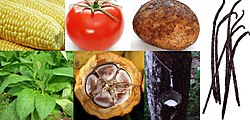Dissemination to the Old World
The transfer of people, crops, precious metals, and diseases from the Old World to the New World and vice versa is called the Columbian Exchange.
Food historian Lois Ellen Frank calls potatoes, tomatoes, corn, beans, squash, chili, cacao, and vanilla the "magic eight" ingredients that were found and used only in the Americas before 1492 and were taken via the Columbian Exchange back to the Old World, dramatically transforming the cuisine there. [17] [18] [19] According to Frank, [20]
If we deconstruct that these foods were inherently native, then that means that the Italians didn't have the tomato, the Irish didn't have the potato, half the British National Dish—Fish and Chips—didn't exist. The Russians didn't have the potato, nor did they have vodka from the potato. There were no chiles in any Asian cuisine anywhere in the world, nor were there any chiles in any East Indian cuisine dishes, including curries. And the French had no confection using either vanilla or chocolate. So the Old World was a completely different place.
This page is based on this
Wikipedia article Text is available under the
CC BY-SA 4.0 license; additional terms may apply.
Images, videos and audio are available under their respective licenses.

